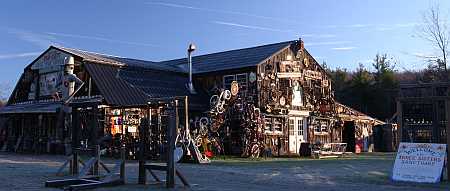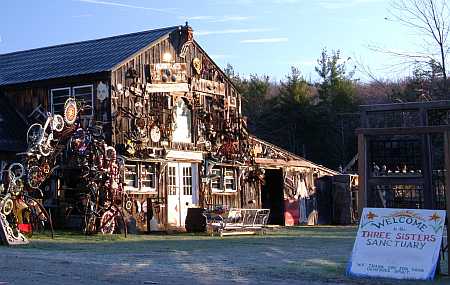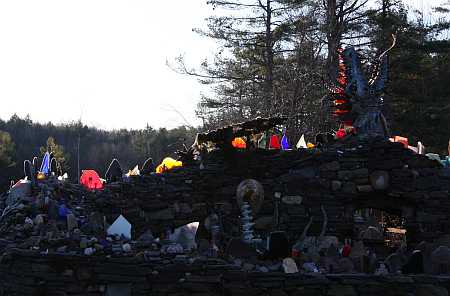Stone by Stone
Garden Sanctuary rises in Goshen
By CHELSEY POLLOCK
Gazette Contributing Writer
Three Sisters Sanctuary - Goshen, ma

The Three Sisters Sanctuary is a garden of sculptural objects created by Richard Richardson.
GOSHEN - Two large stones stand on opposite sides of the grassy landscape. Their white quartz shapes stand in sharp contrast to the countless other darker boulders organized in circular "formations weaving around the yard".
Those two stones are battling sisters fighting it out for attention, says Richard M. Richardson, of Goshen.
Richardson, who has spent the past 15 years carefully developing his ornate backyard garden, said that all stones have a personality of their own. And the dueling sisters are not the only characters in the garden.
A group of tall rocks, which Richardson, 60, calls the Elders, are gathered off to the edge of a drum circle in the backyard.
"They just kind of feel like they have the wisdom of the garden," Richardson said of the group.
A sculpture of a girl made of shells, and other found objects, sits in the Three Sisters Sanctuary in Goshen.

A widely varied collection of large stones are purposefully scattered along the other side of the drum circle. Richardson said that when he stands in the center of the circle and looks out at these stones, he feels like he is at a dance, scanning the potential dance partners. Thus, he calls this formation "Dancing with the Ladies."
Richardson said he is not much of a gardener - and downplays his experience, saying he's just picked things up along the way.
By trade, he restores and sells antique stoves as the owner of Good Time Stove Company in Goshen. But after decorating the interior of his house, he said he decided to move his attention outside.

In the Three Sisters Sanctuary in Goshen brother and sister, Jaime LaBonte and Megan LaBonte stand beneath what Megan says is her favorite part of the garden, the dragon. The garden was created by Richard Richardson, who in an artist in Goshen.
"I started one day when I built one outdoor room and that was fun and there's no restriction," he said. "Outside, you have a room and any other space that abuts it."
Then, one day he was digging a well in his backyard and he found a seemingly unlimited supply of the large rocks buried on the property. As he continued be said the stone just jumped out of the ground.
"They didn’t want to be down there," he said. "They were waiting for me."
Richardson decided to put the stones to good use and began adding new sections to his backyard garden, which he calls the Three Sisters Sanctuary.
"You can really work with what you have and nature can work with you," Richardson said.

Richard Richardson, center, and two of his children, Sara "Stove Princess" LaBonte and Jaime LaBonte, pose with a cylinder stove in the showroom of the Good Time Stove Company on Cape Street in Goshen. At left is a line of parlor stoves (on the floor) and smaller 4 o’clock stoves (above and behind them, along window). The Three Sisters Sanctuary is located behind the store.
The garden now consists of several different elements, like the drum circle, an amphitheater and a sanctuary dedicated to Richardson's late daughter - Tina Marie. The separate "rooms" are connected by winding stone and brick pathways and a series of metal and wood arches.
Here, the natural aid the man-made seamlessly intertwine.

This 16-foot wooden figure representing a woman was built to be burned as a party of Megan E. LaBonte’s "Burning Woman" party, held earlier this month at the Three Sisters Sanctuary.
Rusted bicycles rise from the ground among the grasses and trees. Metal sculptures from various artists are scattered throughout the yard. Colored glass shines from among the rocks of the water garden and from the crevices in some of the stone formations.
Throughout the garden there is a wide variation of plant life. In the spring and summer, the garden is alive with color, Richardson said.
But, he said, "When he plants go away, there's still plenty to look at. It was meant to be a four-season garden."
The yard also incorporates fire with several fire pits, one with a chimney made to look the head of a dragon. The dragon is made of a mosaic of stone, glass and other objects. "When the fire beneath is lit, he appears to breathe smoke into the, and above the garden, Richardson said.

The dragon in the Three Sisters Sanctuary serves as the primary chimney to a fire pit below. Smoke travels out of the dragon’s mouth when a fire is lit.
The hodgepodge of items tucked throughout the yard is a bit overwhelming at first. But, Richardson said, the collection is intended to be an assortment, of interesting forms, rather than a mix of cohesive materials.
"I’m a collector of shapes. If I like a shape, I don't really care what it is," he said. "If at some point it talks to me, I'll do something with it."
It has been Richardson's artistic vision that has sculpted the Three Sisters Sanctuary over the years, with the help of local artisans, stone workers and gardeners, he said.
Richardson said that he sees the garden as his legacy, his gift to the Pioneer Valley.
"Without trying to seem like I'm flattering myself, I do believe that it is of some great substance," Richardson said. "I believe that it is more than just a backyard."
All of this creation hides behind the Good Time Stove Company building on Route 112 in Goshen.
The building is decorated with an array of found objects many of them rusted red or painted with bright colors. Richardson said that an average of 10 people per week used to stumble upon the garden, after stopping to check out the eye-catching building or the two-story tall tin man who stands sentry nearby.
But after recently posting a sign welcoming the public to visit the garden, Richardson said he has seen those numbers jump to 50 to 100 people on the average week While the high traffic has been an adjustment, Richardson said he is excited to see the rising interest in his work. "The only way it can really be used is if I share it," he said. And it teaches people how environmental art works; whether they are children or adults matters not."
Next venture: Richardson's next project will be to develop the furthest edge of the garden, where. the dueling sisters sit, into a labyrinth called "the Dance of Life." The labyrinth will take visitors through different. Rooms, representing courtship, seduction, commitment, conception, childhood and adulthood. The final section of the labyrinth - the Exit of Life- will drop visitors back into the main garden. Richardson says he hopes to complete the labyrinth in two to three years.
And after a hard day's work Richardson only needs to walk a few feet from the garden to his home, where he and his family have lived for almost 35 years. "My favorite part is that I live here," he said. "I live inside of my art."











